- Craig's Current
- Posts
- Craig's Current - July 2025
Craig's Current - July 2025

I hope you are enjoying the summer and have been able to stay cool during the extreme heat we have experienced. There’s been a lot happening at City Hall, and much to report. We pack every edition of Craig’s Current with a lot of information and want to make it as easy as possible to read the content that most interests you. So, in the spirit of continuous improvement, we’ve updated this introduction section with a direct link to each article. This feature will allow you to quickly navigate to the topics you want to read and then pop right back up to the table of contents by using the ‘back to top’ link. If you find the links don’t work in your email program, just click on the ‘Read Online’ link in the top right corner of this message and read the newsletter in your web browser. I hope you find this update useful, and I am sincerely grateful for your engagement in our city.
Council News
Around Ward 12
In Other News
Happening Around Hamilton
Climate News

PROTECT OUR FOOD ACT (Bill 21)
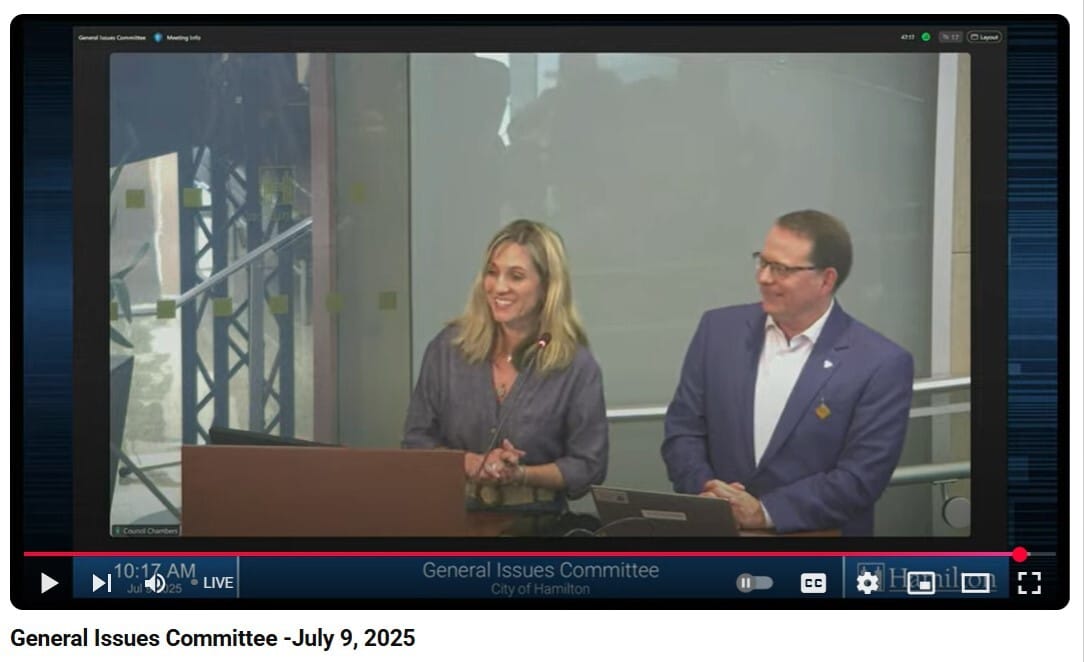
MPP Bobbi Ann Brady and MPP Mike Schreiner delegating to the City of Hamilton’s Planning Committee
At the July 9th General Issues Committee meeting, we received a delegation from MPP Mike Schreiner, Leader of the Ontario Green Party, and independent MPP Bobbi Ann Brady, urging Hamilton Council to support their Private Members Bill - "Bill 21 Protect Our Food Act". Also delegating in support of the Bill was Ontario Federation of Agriculture President Drew Spoelstra. It was great to hear all three delegates praising Hamilton for preserving prime farmland by stopping sprawl and instead focusing on intensification within our current urban boundary.
If enacted, Bill 21 would enable the creation of an agricultural working group led by farmers who would make recommendations on a preservation plan, including a report on key priorities such as:
reducing speculation on the future price of farmland
improving soil health
protecting and enhancing farmland
outlining the contours of a protected Foodbelt
Why is a Foodbelt necessary?
Over the past 35 years, Ontario has lost 2.8 million acres of farmland, or 18% of our agricultural lands. Less than 5% of land in Ontario is suitable for agriculture, and only 0.5% is prime farmland capable of growing crops under adverse conditions. And yet, we lose 319 acres of this precious farmland every day to urbanization, highway projects, aggregate projects, etc. That is equivalent to 9 family farms, 24 million apples, and 37 million strawberries. A Foodbelt would protect and improve our agricultural lands and ensure the viability of Ontario's annual $50 billion agricultural industry, employing over 900,000 people.
A unanimous vote in favour of Councillor McMeekin's July 9th motion to support Bill 21 demonstrates Hamilton's support for Bill 21 and our commitment to protecting farmland. The Bill is expected to receive second reading at the Provincial Legislature in 2026.
You can read Councillor McMeekin’s motion at this link.
You can watch the delegations and the subsequent questions at this link.
You can read more about Bill 21 at this link.
ROAD SALT MOTION

An example of the excess salt often applied to Hamilton’s roads and sidewalks
At the Public Works Committee on Monday, July 7th, I introduced a motion to put Hamilton's support behind a Province-wide push by many municipalities, industry and environmental organizations, and knowledgeable citizens urging the Province to take action on the impacts that overuse of road salt and a lack of a liability framework have across our Province. There are wide-ranging negative impacts on our environment (not the least of which are contributions to blue-green algae blooms in our water bodies), soaring insurance costs for landscapers, threats to the viability of landscape businesses, increased cost of services to consumers, and premature deterioration of our infrastructure. Thanks to Ward 13 Councillor Alex Wilson for seconding it, and to the two delegates who spoke to the Committee and shared their knowledge. The motion was supported by Committee and ratified at Council.
You can read my motion at this link
You can watch the video of the motion being introduced at this link
You can watch the delegations at this link.
HAMILTON OPPOSITION TO PROVINCIAL BILL 5
At the July 8 Planning Committee meeting, Staff presented the comments they submitted to the Province in response to “Bill 5 – Unleashing our Economy Act”. The Act was rushed through the Ontario legislature with virtually no public consultation, even excluding the Indigenous Nations that would be most affected by it. A lot of harm could be caused by this bill. For me, it evokes the image of a ferocious beast being unleashed onto Ontario’s Endangered Species Act, Indigenous rights, local decision-making, and onto democracy as a whole. At the meeting, I introduced an amending motion, adding sections 3 and 4 below, so that the City of Hamilton could make our stance clear to the Province:
3) That the City of Hamilton opposes the Government of Ontario’s Bill 5 due to its infringement on Indigenous rights, assignment of powers to arbitrarily override and ignore long-established areas of municipal government authorities, risks to the long-term health of important ecosystems and the environment generally, and circumvention of numerous democratic rights and oversight responsibilities; and,
4) That the City of Hamilton call on the Province of Ontario to obey their own rule of law, to pursue housing, forestry, infrastructure, and critical mineral development through policies that follow sound environmental planning principles, uphold the planning authority of local government, respect Indigenous treaty obligations, and protect vital ecological systems
My amending motion passed 9-0. Watch the video of the introduction, discussion, and vote at this link.
Staff’s comments to the Province are item 9.4 at this link.
Mike Schreiner’s Hamilton Spectator article on Bill 5 can be read here: Bill 5 is a threat to farmers and Ontario’s food sovereignty
CHCH coverage of the Kill Bill 5 rally at City Hall on July 9 is HERE.
Finally, should you be interested in taking action, “All in for Hamilton” is a free and local community event focused on mobilizing against Bill 5. It’s on July 31 from 6pm – 8pm at 51 Stuart St. More info HERE.
INTENSIFYING WITHIN THE URBAN BOUNDARY
As you read in the June 2025 issue of Craig’s Current, Council continues to support a firm urban boundary. In order to achieve our housing targets, we require intensified development within the current urban area. We have a huge amount of underutilized land across the city that can enable tens of thousands of homes. This past week, Council took steps to enable two important developments to support our vision.
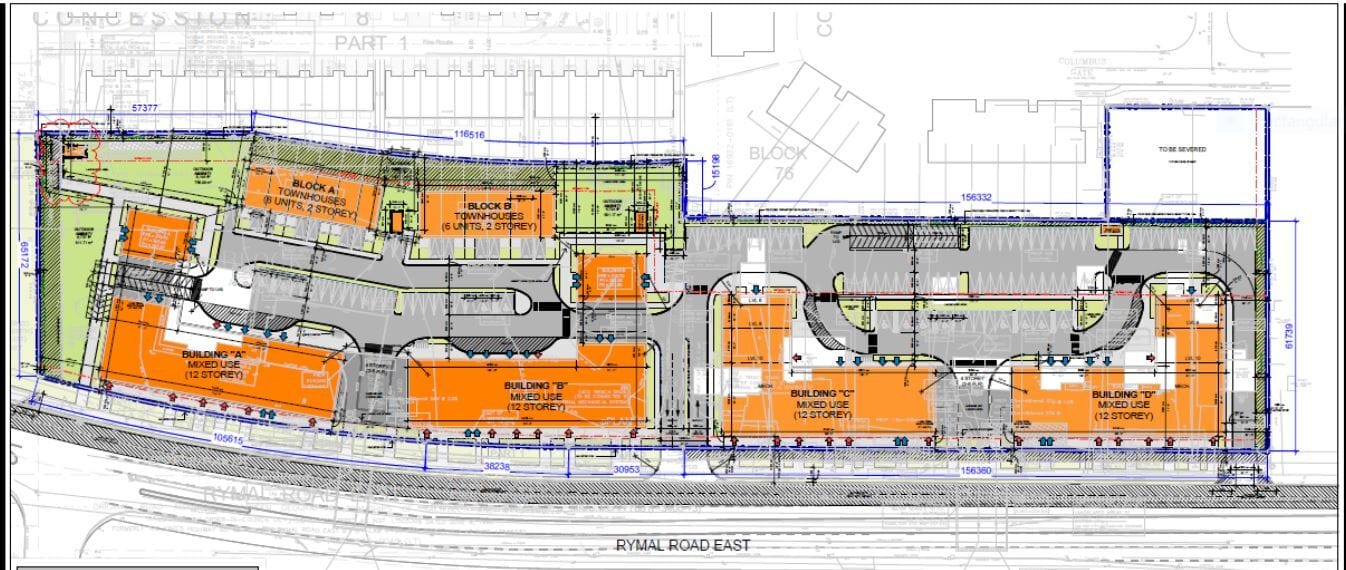
Rymal Rd E at Trinity Church Rd: concept design
The first is a proposal on Rymal Rd E at Trinity Church Rd that will create 812 homes on land currently occupied by 8 single-family homes. The proposal is for four 12-storey mixed-use buildings, meaning there would be retail shops on the ground floor and residential above. It would also have two blocks of two-storey townhouse dwellings, and a block for future low-density residential. Rymal Rd is a designated transit corridor and is intended to be part of the city’s BLAST network, a plan for five higher-order transit lines throughout the city. The LRT line between McMaster and Eastgate Square is the ‘B’ of the Blast network. The other four lines envisioned are illustrated in the diagram below.

The BLAST network: a vision for higher-order transit in Hamilton
Note that the forthcoming ‘HSR Next’ overhaul (the first full re-design in over a century) of our transit system will add a sixth higher-order transit corridor. I’ll share more about that when the report is brought to Council.
For the Rymal Rd E development proposal, you can see the materials submitted and Staff comments on the July 8, 2025, Planning Committee agenda at item 8.1. Council voted to support this development.
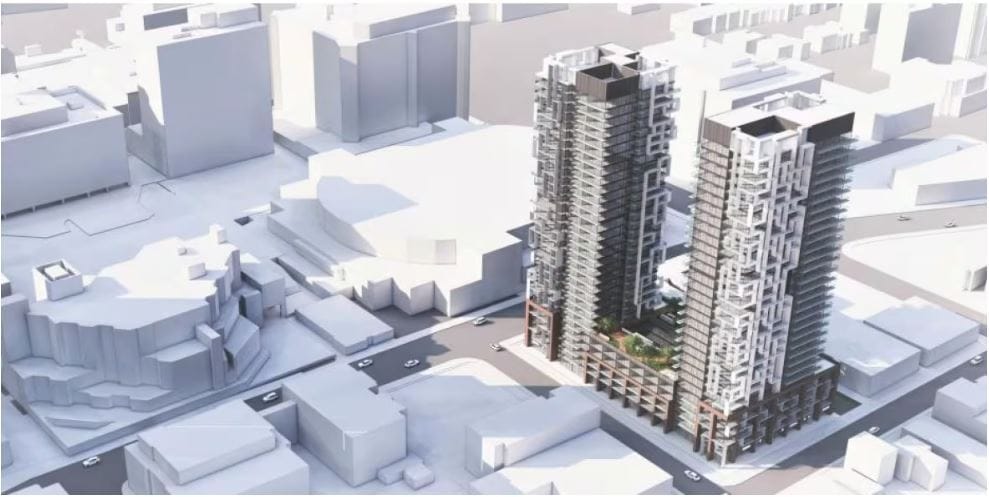
The concept design for 84 York Blvd, the current site of Philpott United Church
The second important development is Council’s decision regarding the Philpott United Church at 84 York Blvd, just across the road from the downtown arena, newly renamed TD Coliseum, but more familiar to many as Copps Coliseum. A year ago, Council took steps to preserve heritage elements of the church while still enabling the congregation to sell their property, thus allowing development to proceed. Without any progress over the past year, the congregation and the developer have both recently urged Council to withdraw the City’s notice of intention to designate (the property as a heritage site). Council concurred and is allowing the intention to lapse, which we believe will allow a mixed-use project with 600 homes to proceed.
More projects like these are critical, not only to hitting our housing targets for our growing population, but also for improving the tax productivity of our land and minimizing the property taxes we all pay. Intensification gets more revenue from the land and infrastructure we already have, whereas expanding the boundary just continues the growth Ponzi scheme we’ve been subjected to for decades and deepens the financial hole we are already in.
DOWNTOWN REVITALIZATION STRATEGY
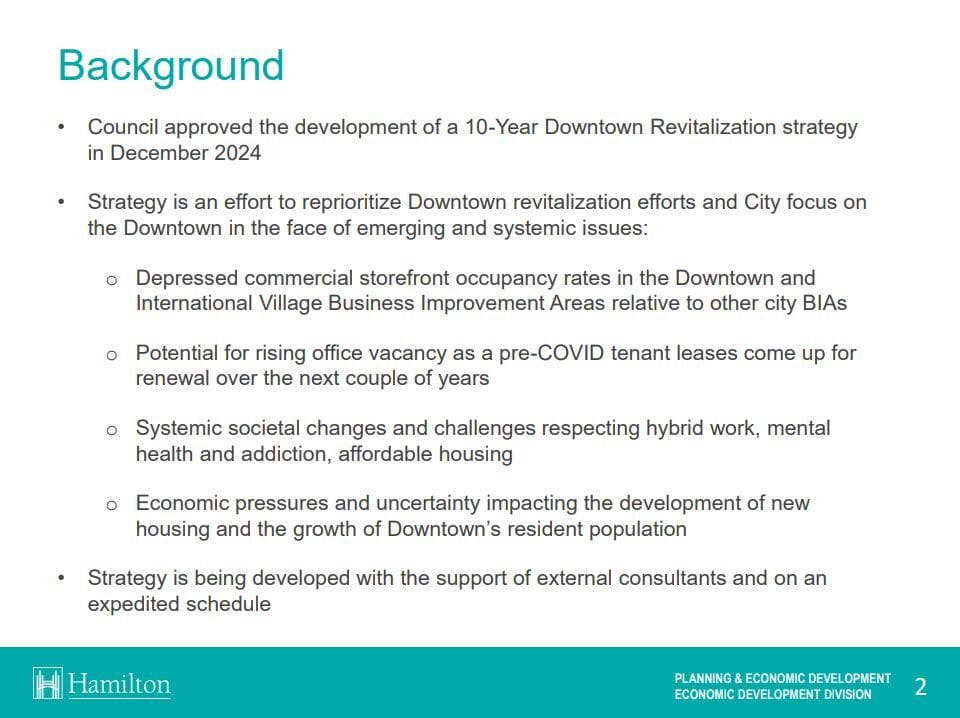
An excerpt from the 10-Year Downtown Revitalization Strategy update
The vitality of any city’s downtown core is essential to its success. Over the past few years, there has been a lot of positive change happening in the downtown – a surge in residential projects like McMaster’s new graduate residence, Television City breaking ground on Hunter St W, a new condo building at 75 James St S next to the YMCA, the new King William rentals; $280 million renovation of our downtown arena (recently named TD Coliseum); and early works for the LRT project getting underway.
However, the lingering impacts of the COVID pandemic, as well as more recent economic challenges and threats, have halted the momentum and created significant concern about the downtown’s near-term future. Challenges, including but not limited to a decreased working population downtown due to remote working arrangements, increased homelessness, and businesses and other services leaving the downtown area, require action.
In December 2024, Council approved initiating a 10-year downtown revitalization strategy. In July 2025, we received the first update as Staff and our consultant collect feedback and work on the strategy, which is expected to be presented to Council in Q1 2026.
You can read the presentation from General Issues Committee at this link.
You can read all the ideas submitted by Hamiltonians to improve downtown at this link.
Further, a recent front-page article in the Hamilton Spectator covered this topic and highlighted that despite the very real challenges in the downtown (including a very recent tragic shooting), its unsafe reputation isn’t fully warranted when compared to stats from the rest of the City. In fact, violent incidents and calls for property crime in downtown are down versus 2024. The article goes into more depth and also covers the Hamilton Police Service’s core patrol of six officers that was created in 2023 and has been positively received.
You can read the Hamilton Spectator article at this link.

EMANCIPATION DAY AT FIELDCOTE

Every year on August 1st, we celebrate the abolition of slavery across the British Empire and the resilience and vibrancy of the Black Community. Please join me at Fieldcote Memorial Park & Museum to recognize this important day and honour the life and legacy of Enerals Griffin, who is memorialized just a couple of kilometres down the road at Griffin House National Historic Site
This year’s exciting event will include live performances by internationally recognized percussionist Walter Maclean, Canadian singer-songwriter and steelpan virtuoso Luckystickz, local choirs, food trucks, and games on the beautiful seven-acre grounds of Fieldcote!
WARD 12 COMMUNITY GRANTS

A list of this intake’s recipients of Ward 12 Community Grants
Ward 12 is fortunate to receive annual non-property tax revenue from cell towers located within the Ward. These funds are available to spend within the Ward at the discretion of the Ward Councillor. Several other Councillors have similar cell tower revenue as well as much larger area-rating funding, which is an artifact of amalgamation. With those funds, they have established a community grants program, a concept that I have just implemented for Ward 12.
In early June 2025, I announced that local non-profit organizations and charities could apply for one-time grants up to $5,000. I am very excited to announce that a total of just over $50,000 has been awarded across 12 local organizations! The next call for applications will be in early 2026, so watch for the announcement in Craig’s Current and, of course, my social media channels.
You can read more about the grants program and see the 2025 recipient list on my website.
GARNER ROAD CONSTRUCTION UPDATE
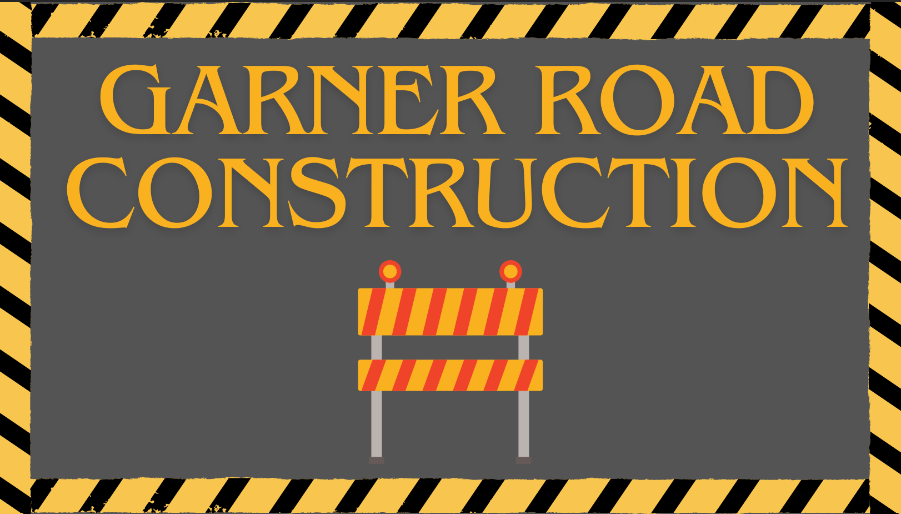
Over the past couple of weeks, I’ve posted updates about construction on Garner Rd. Here is a quick recap:
WATERMAIN REPLACEMENT: between Panabaker Dr and Fiddler’s Green Rd
The temporary restrictions at Garner Rd and Fiddler’s Green Rd were removed on July 18. The planned 4 weeks of work in this intersection were extended from June 9 because of two extreme heat days, two days of significant rain, and underground locations of utilities that did not match the locates provided by third parties (telecommunication, gas, hydro).
Although that part of the project is complete, there has been a setback in full completion. The opening of the eastbound lane between Panabaker and Fiddler's is delayed until the back half of August. A more specific date can be shared as we get closer to the date. You would be correct to recall that I have previously shared a mid-July full re-opening date. The contractor has failed to communicate the complications and delays they have experienced. This is an inexcusable failure on their part. In my conversations with senior City Staff, on behalf of everyone in Ward 12, I made it extremely clear that we deserve much better communication, especially in light of the challenges they have encountered. These kinds of projects are complicated, and I committed to transparent and timely updates to you, so it is completely unacceptable for the contractor to withhold such significant information and reveal it within days of the project's expected completion. I asked about improving the projected date, but they are too far behind the previous status they had provided. You may ask if there is a penalty for the contractor. No. The contract with the City has always been to complete the work by November 30, 2025. They will still finish well ahead of that date.
I am sorry to have to share this news. I am also angry and frustrated. But as I have said before, executing construction projects is not a political process; a Councillor does not have the authority to direct the work. I can only commit to sharing updates as I receive them.
SEWER LINE REPLACEMENT: between Redeemer University and Raymond Rd
This project did not wrap up on July 18 as the contractor had previously indicated to City Staff. This sewer installation project is a completely separate project and a different contractor from the watermain project referenced above. This contractor has been significantly underperforming and has not met their commitment. I can tell you that City Staff have read them the riot act and advised them that they will be charged liquidated damages for breach of contract. The estimate provided to me is for an end-of-August completion. I will provide another update closer to that date or if anything changes.
SAFETY ON RURAL ROADS UPDATE
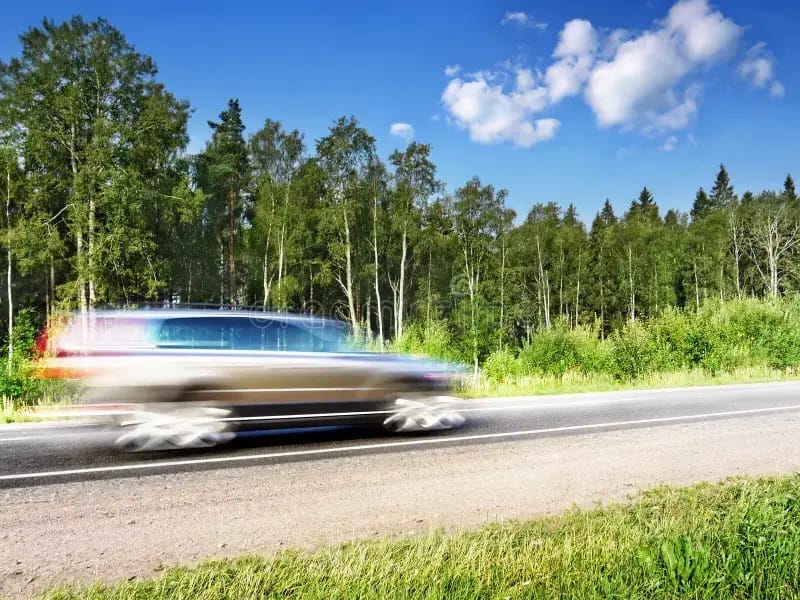
You may recall that in response to ongoing concerns about unsafe driving on rural roads, including excessive speed, unsafe passing, and ignoring stop signs, I took action in December 2024 with a motion - supported by all of my colleagues - directing Staff to investigate best practices and provide Council with options to improve road safety on Hamilton’s rural roads.
Prior to this motion, there had been a large increase in traffic calming across the City’s urban areas, where there are already many tools available; however, there are very few options available for rural roads, even though these communities are also experiencing an unacceptable increase in dangerous driving. Although there are not yet any specifics to share, I have recently received an update from the Director of Transportation, and I am expecting Staff recommendations to be presented to Council in the Fall.
As a reminder, my motion directed Staff as follows:
(a) That the Transportation Division be authorized and directed to complete a jurisdictional scan and consulting assignment to review best practices and other available tools that could be effective in enhancing road safety for all road users on Hamilton’s rural roads and report back in Q3 2025;
You can read my full motion here.
RURAL ROADSIDE CUTTING UPDATE
My office is aware that rural roadside cutting is delayed this year. Here’s what we’ve been told by City Staff:
Two new rural mowing contracts were awarded to assist with the city’s rural areas. While both contractors are actively working on their assigned routes, progress to date has been slower than anticipated. City staff are closely monitoring their performance, providing direction to help address delays, and additional assistance is being sought to supplement the work and ensure the timely completion of mowing operations.
Currently, work is underway in Waterdown and will commence in Ward 12 in about one weeks’ time. Thank you, everyone, for your patience.
STOP SIGNS FOR TRAFFIC CALMING?
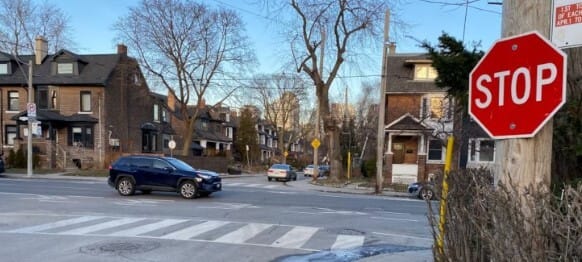
Speeding and aggressive driving are topics that I hear about from residents daily. It’s something that I see and experience, too. The emails and calls my office receives are rooted in the fear that someone is going to be seriously hurt or killed on their street. Safety in our community (both being safe and feeling safe) is a basic right that everyone should have. Unfortunately, the way much of our city has been designed – creating car dependency and designing everything around the priority of moving cars quickly - has made it quite unsafe, especially for people not in a vehicle.
So, what to do?
Many residents who are solution-oriented implore the City to install more stop signs to slow down traffic. This is such a common occurrence that I reached out to City Staff to provide feedback on this topic. It’s a detailed response which I urge you to read:
“Transportation staff follow guidelines set out by the Ontario Traffic Manual (OTM) to justify the installation of stop signs. It is important to note that stop signs are not to be used as traffic calming devices. Stop signs serve a critical function, and their placement should not be arbitrary. Misplaced signs tend to lower compliance, which can be dangerous. The intended function of an all-way stop is not to reduce vehicle speeds but rather to allocate the right-of-way control at an intersection between two roadways with a nearly equal volume split for cars approaching from both streets, as well as meeting a minimum total volume threshold. The only exceptions are if the intersection meets a specific collision threshold or has unresolvable sightline issues. These are the warrants which are required to be met according to the Ontario Traffic Manual (OTM) to justify the installation of stop signs. The OTM also maintains that stop signs are never used for speed control. Some of the consequences of installing unwarranted all-way stops include:
Rolling stops (due to motorists on the higher volume street rarely seeing conflicting vehicles or pedestrians), giving pedestrians and other drivers a false sense of security;
Increased noise and air pollution for area residents;
Increase response time for emergency vehicles;
Additional vehicle delays contributing to increased driver frustration and aggressive driving.
Numerous studies have shown that speeds within a block of the stop sign are largely unaffected by the stop. Naturally, motorists have to slow down when approaching a stop sign, but they often speed up quickly after the stop to make up for lost time. Overall speeding is not reduced by the stop sign.”
The best way to make our neighbourhoods safer is to design them properly when they are built. Unfortunately, most of our streets – including neighbourhood streets – are far too wide and open and have not been built with safety in mind. Until a road is scheduled for reconstruction – which could be decades in the future - we are left with retrofitting it with engineering interventions. Speed cushions are by far the most common technique because they are relatively cheap and easy; however, the City has only so much capacity for even this simple intervention, so the demand outstrips the requests across all 15 wards.
I’ll leave you with a short article about some traffic calming options, should you be interested in reading some more. You can link to it HERE. An additional intervention not covered in that article is the topic of the following article, so keep reading below.
Finally, a reminder that when you share a Ward 12 safety concern with my office, we pass it on to staff and record it – and any follow-up actions – on a custom map. You can access it at this link.
STONEHENGE BOLLARDS

City Staff have informed me that bollards will be reinstalled on Stonehenge Drive in the very near future. As I know that there were many opinions when they were introduced, Staff have provided the following overview. I have added some of my experiences:
Used in the context of a street like Stonehenge, bollards serve multiple purposes:
They slow vehicles down while navigating the roundabouts, making it safer for people to cross the road on foot.
They provide some protection to people using the bike lanes by defining vehicle paths more clearly and discouraging unsafe movements such as corner cutting or lane encroachment. (Note: fully separated cycling infrastructure would be safer for everyone, but this project was designed and funded before I was elected, so I did not have input).
They serve as a traffic calming device to improve compliance with the 40km/h speed limit on this street.
Bollards are designed to influence driver behaviour by creating a visual and physical narrowing of the roadway. This effect encourages motorists to reduce their speed and drive with greater caution, making the roadway safer for everyone. Further, as you are likely aware, distracted driving because of cell phone use is a widespread issue. Requiring people to focus on the road ahead reduces distracted driving.
Aggressive driving is another topic I hear a lot about, including on Stonehenge. My office has received many complaints, and I have experienced far too many incidents of dangerous and aggressive driving, including being passed (the driver crossed the yellow centre line into oncoming traffic), where the offending vehicle nearly created a head-on collision with another car right in front of me.
Known as knockdown bollards, the product used on Stonehenge Dr and around the city is not designed to stop a vehicle, but their vertical presence creates a clear boundary that visually reinforces appropriate lane use. Their flexibility allows them to bend when struck, reducing the risk of injury or vehicle damage, which makes them suitable for urban environments.
I've heard concerns about the frequency of bollards being hit and dislocated, and the resulting maintenance cost. First of all, when bollards are hit, it demonstrates that vehicles are not staying in the lane and that there is a safety risk to people outside a vehicle. Further, the flex bollards used are designed to sustain contact, and if dislodged, can be reattached by maintenance staff. The cost for the maintenance crew is covered by the annual Transportation budget.
Looking at industry best practices, the Transportation Association of Canada (TAC) includes flexible bollards as a recommended treatment in its Geometric Design Guide for Canadian Roads, particularly on streets with speed limits of 50 km/h or lower (and remember, the speed limit on Stonehenge is 40km/h). TAC identifies bollards as a cost-effective and adaptable measure that can contribute to safer road environments, especially when used in conjunction with other traffic calming treatments.
Despite their benefits, knockdown bollards can pose operational challenges in winter. Their placement can interfere with snow-clearing operations, particularly in constrained corridors, and repeated contact with snowplows may cause misalignment or damage. As a result, some bollards are removed seasonally to facilitate effective snow removal and preserve the bollard infrastructure for reuse.
Finally, I've been asked about how emergency vehicles will be affected by the bollards placed near roundabouts. Staff have confirmed that those considerations are made during every road design and installation, including Stonehenge. I've personally watched firetrucks, ambulances, school buses, and garbage trucks navigate them safely, with no issues. They just slow down. If they can do it, so can we in our own vehicles. Just slow down. It only takes a couple of seconds, but it makes the neighbourhood so much safer for everyone.
You can read some research about the economic benefits of protected bike lanes at this link.
RICHARDSON HYSLOP FREBOLD HOUSE UPDATE
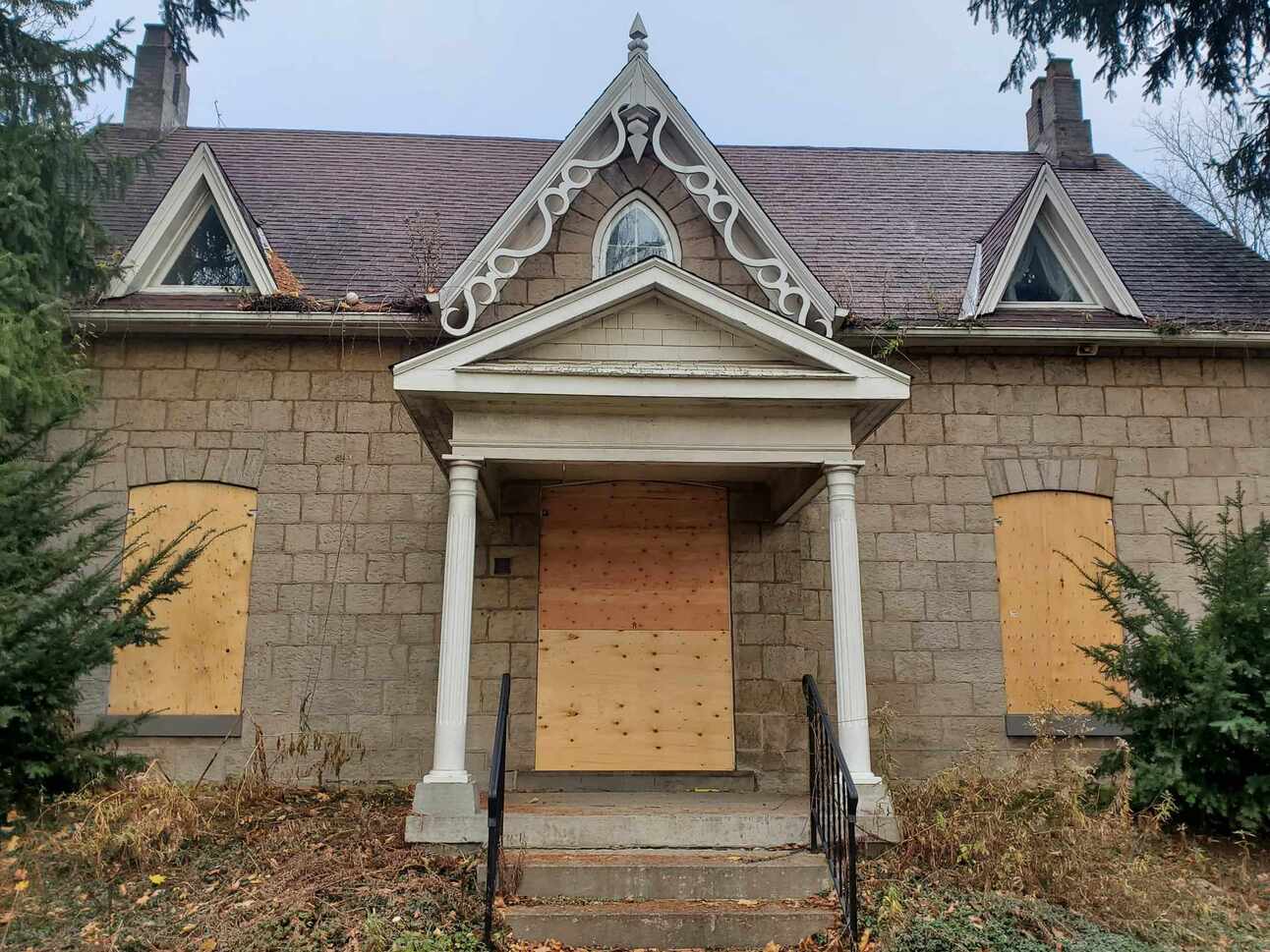
I have a brief update for the status of the heritage property (Richardson Hyslop Frebold House) at 243 Garner Rd E. City of Hamilton Municipal Law Enforcement had previously issued orders to comply with a deadline of July 1. That date has passed without compliance.
The garage has been closed off and secured, meaning it is no longer open to trespassers. However, the property is still in non-compliance, and as such, Municipal Law Enforcement will be issuing charges, adding fees for service, and engaging a contractor for work not completed below:
Eavestroughs clean out and repair.
Downspout extensions or repair
Painted wood windows black
Painted door black
Exposed metal post on the ground
Connecting building utilities
Associated fees for service and contractor work will be added to the property owner’s tax roll, and work should be completed in the next few weeks.
PORTABLE TOILETS IN PARKS
My office received feedback about the lack of toilets in some public parks, so I put forward a motion to use Ward 12 non-property tax funds to have portable toilets available in Meadowlands Community Park (160 Meadowlands Boulevard), Amberly Park (284 Nakoma Road) and James Smith Park (50 Braithwaite Avenue) for the remainder of the summer season. Look for them to show up soon!
CATHOLIC YOUTH ORGANIZATION

A warm welcome from campers and staff at the CYO camp at Immaculate Conception School
The Catholic Youth Organization (C.Y.O.) is a non-profit based in Hamilton that serves over 45,000 youth each year across the GTHA by facilitating athletics, outdoor education, and summer camp programming.
On July 23rd, I had the pleasure of meeting a group from the C.Y.O Athletes in Action sports camp at Immaculate Conception Elementary School. Children ages 6-13 at this camp engage in a variety of indoor and outdoor sports activities while learning co-operation and leadership skills.
If you're looking for summer fun for your children, spots - including extended before and after care - are still available. Camp will be running at Immaculate Conception C.E.S. for the whole summer, from 9am-3pm. Contact Morgan Cleugh, Camp Registrar, at 289-925-5063. For further information and to register, click here.

YARD MAINTENANCE BY-LAW REVIEW

As part of Hamilton's Biodiversity Action Plan (BAP), the City is reviewing and updating its Yard Maintenance bylaw to better support naturalized areas on private property, such as pollinator gardens, native plantings, and rewilded spaces. This update is focused on clarifying rules around naturalized yards while continuing to manage yard maintenance standards and ensure public safety.
Key parts of this review include:
Defining what counts as a "naturalized area" under the by-law
Setting clear height limits for turfgrass species
Exploring the addition of a list of nuisance weeds (in addition to the provincially mandated list under the Weed Control Act)
Your input is needed! Please fill out the survey at Engage Hamilton
RURAL ONTARIO DEVELOPMENT COST SHARE GRANTS
Calling on small businesses in Rural Hamilton! Did you know about the Province of Ontario’s Rural Development Grants? New funding is available from the Government of Ontario to help create strong businesses, boost economic growth, protect jobs, and improve infrastructure in small communities.
Who is eligible?
To qualify for the ROD Program, you must meet both of the following requirements:
Your organization must be one of the following:
a municipality
a not-for-profit organization
an Indigenous community or organization
a local services board
a small business with 1 to 20 employees
Your project must be within an eligible rural area of Ontario
Application Deadline for the first intake period is September 24, 2025, at 5 p.m.
All the details are at this link.
CRAIG ON THE STRONG TOWNS PODCAST
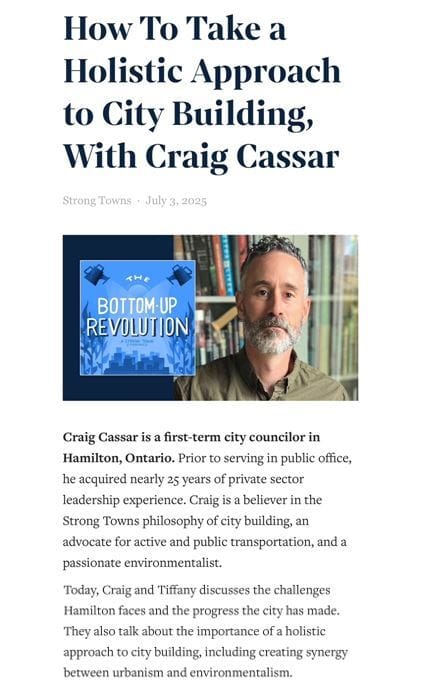
I've spoken often about Strong Towns and the wealth of knowledge and insight they provide into sustainable city building and municipal finance. Their work has been an excellent source of knowledge for me as Hamilton tackles the desperate need for more housing while simultaneously dealing with a $5.4 billion infrastructure spending gap over the next 10 years. So, I was privileged to be interviewed on the Strong Towns Bottom-Up Revolution podcast. You can listen to it here.

Hamilton Philippine Heritage Festival July 25 – 27, Bayfront Park
Assyrian Festival of Nusardil - July 27, 12pm – 8pm, T.B. McQuestin Park
Ancaster Memorial Arts Centre - has various events during the month of August.
Emancipation Day - August 1 from 2pm – 6pm. Fieldcote Museum
Community Salsa Dancing – August 7 - Ferguson Station
Art Crawl – August 8, James Street North, 5pm till late
Downtown Hamilton Park Crawl – ongoing August 8 – September 14
Sunset Series 5km race - August 28, 6:30 – 8pm
Sundays Unlocked - Sunday, September 21 – Locke Street – Vendors and entertainment
Patio Season on King William Street - ongoing through the summer
Steel City Swing Dancing – Sundays, 6:30 – 9:00, Pier 8. Free lesson at 6:30!
Dundas Concert Band Summer Series - Various dates, Dundas Driving Park Bandshell
Hamilton Public Library Concert Series – Various dates and locations
Ancaster Autumn Stroll – September 7, tickets on sale now

CLIMATE CHANGE: BY THE NUMBERS
The evidence of climate change is all around us. From the destructive events like the town of Jasper, AB burning in 2024, to the 5.5 million hectares of forest fires (267% of the 10-year average) burning in Canada as I write this, to the more local extended heat warnings and heat domes we continue to have, and the more intense storms we experience since warmer air can hold more moisture.
Despite these drastic changes, it’s very easy to find out how the various stock market indices perform each day, but reporting on metrics related to our impact on the climate, like CO2 concentration, is quite rare. In that spirit, I’m sharing some of those facts with you here.
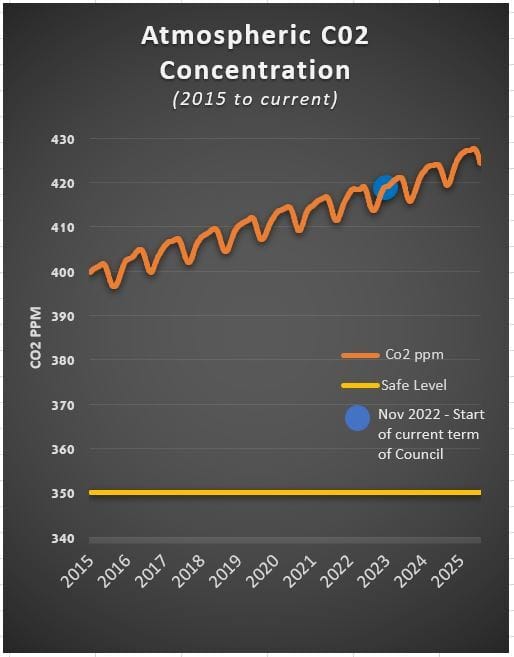
First is the recent history of the atmospheric concentration of CO2 since 2015. As you already know, it’s greenhouse gases like CO2 that have created the global warming that is wreaking havoc on our climate. As shown on the chart, the concentration of CO2 is now around 425ppm, and there is a relentless upward trajectory that is far beyond the safe level of 350ppm. The variation you see each year is caused by the Earth’s deciduous forests losing and then regrowing their leaves. When they leaf out in the spring/summer, they will absorb more CO2, and the concentration nudges down ever so slightly. Simply as a point of reference, I have indicated when this current term of Council began in November 2022.
The next aspect of the Climate Crisis to understand is the effectiveness of reducing our emissions. Like most countries, Canada is a small part of global emissions, but the atmosphere has no borders, so each country’s contribution is important. In the following chart showing national emissions from fossil fuels since Confederation (1867), Canada’s emissions have more or less flattened out in recent years, but our Paris Agreement emissions target is a reduction to 45% of 2005 levels by 2030. With the most recent data (2023), we have only achieved a 4% reduction since 2005, and have only 7 years to go. We’d need about an 8% reduction each year to meet our goal. It’s important to note that the only years we saw reductions in that range were a 6% reduction in 2009 during the financial crisis and a 10% reduction in 2020 during the pandemic. We need quick and decisive action.

Canada’s annual CO2 emissions from fossil fuels and industry since Confederation in 1867. The only meaningful annual reductions have been from the financial crisis and the COVID-19 pandemic (highlighted).
Finally, it’s also important to understand per capita emissions, and this is an area where Canada does not fare well. The U.S. has historically been the biggest offender on this metric, but they have closed the gap on Canada. Although Hamilton may only be a small part of a small national population, we do have the ability to contribute, and based on a late-breaking advisory opinion from the International Court of Justice, a "clean, healthy and sustainable environment" is a human right. Policies like our green building standards that significantly reduce emissions from new homes, and freezing the urban boundary, which enable more efficient housing and transportation, are meaningful ways we can do our part. This is the bigger picture I have in mind as Council makes decisions.

The US and Canada are the largest per-capita emitters of CO2 from burning fossil fuels
CALLING WARD 12 POLLINATOR GARDENERS

The pollinator garden at the Municipal Service Centre is really taking root! Planted and maintained by volunteers, these Ontario native perennials are proving popular with the local pollinators. If you'd like to learn more about native gardening and help steward the native gardens in Ancaster, please drop an email to [email protected]! For more about native pollinators, follow Butterflyway Hamilton on Facebook and Instagram.
BIODIVERSITY ACTION PLAN ANNUAL UPDATE
The City of Hamilton Biodiversity Action Plan actions are intended to build on the commitment made by the City as a signatory to the Montreal Pledge, which called on cities across the world to take 15 tangible actions towards preserving ecosystems, and represent City initiatives that are planned over the next five years that will contribute positively to conserving and protecting nature. The City of Hamilton is the leading partner on 32 of the 68 actions in the plan and a supporting partner on 24 actions. Read the reports and see the presentation slides HERE. Watch the video of the meeting HERE.
BIRDS OF ANCASTER
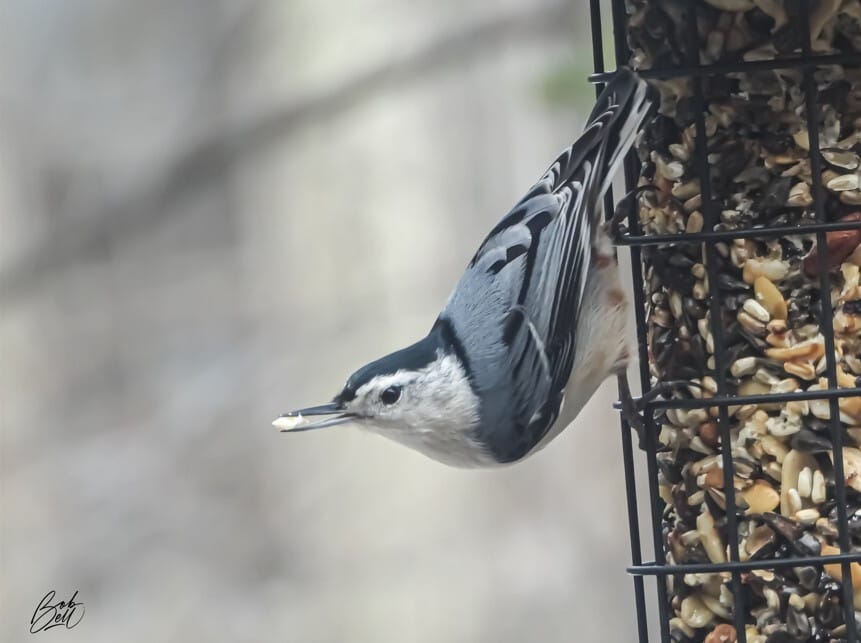
White-breasted Nuthatch
Thanks to Ancaster resident Bob Bell, “The Birder Bob” for another great shot of birds in the community! “White-breasted Nuthatch is the larger of the two nuthatch species that we have; the smaller being the Red-breasted. Listen for their nasal “yank-yank” or “beep-beep” calls, as they forage on tree trunks, often hanging upside down.”
THANK YOU
Thanks as always to everyone who reaches out to engage with our office. I hope you enjoyed reading this month’s newsletter. Please share it with Ward 12 neighbours and friends. If you have questions, feel free to reach out to us at [email protected] and subscribe to the Ward 12 newsletter at CraigCassar.ca. Follow me on Facebook, Instagram, and Bluesky.